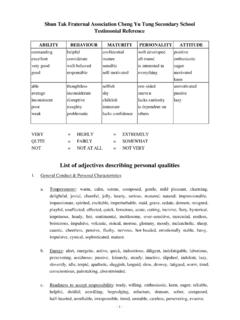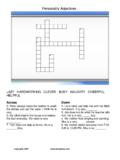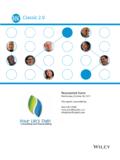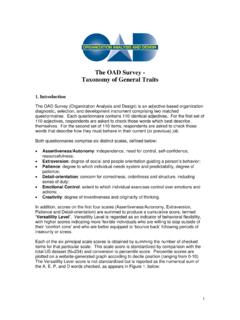Transcription of TRUE COLORS™: NEW IMPLICATIONS FROM …
1 TRUE COLORS : NEW IMPLICATIONS FROM CONVERGENT VALIDITY RESEARCH WITH THE MYERS-BRIGGS TYPE INDICATOR Stevie L. Honaker, Copyright 2001, Journal publication expected, 2003 National Career Development Conference, Westminster, Colorado June 27, 2003 _____ The purpose of this research is to compare a more recently developed personality assessment, with several of the most widely used and well-researched personality and interest assessments available. Results revealed support for the convergent validity of the True Colors personality Typing System with the Myers-Briggs Type Indicator, while little support was found for convergent validity with the Strong Interest Inventory or the Campbell Interest Skill and Survey. IMPLICATIONS are discussed, as well as specific application suggestions for professionals using True Colors two methods of personality typing. INTRODUCTION With the increased use of the True Colors nationally over the last twenty years to date, no manual detailing any psychometric properties was revealed in a search from 1979 to 2001.
2 In the last few years this assessment tool has moved from educational environments into the corporate environment in management training, team building, and training new employees. As evidence of this trend is a book by Carolyn Kalil (1998) titled Following Your True Colors To The Work You Love which has had a second printing. Several of the books recent orders were from Fortune 500 companies. The purpose of this research was to conduct a convergent validity study of the True Colors Character Cards Activity and Word Cluster instrument using the three mentioned well-established assessments. Note convergent validity is defined as research with the purpose to show the test has strong positive correlations with other measures of the construct and smaller positive ones with those related to the construct. (Krathwohl, 1998, p. 434). SIGNIFICANCE OF THIS STUDY Specific information on how the dimensions of True COLORS and MBTI actually relate.
3 RESEARCH APPROACH The study was a basic associational design. The independent variables were the True COLORS personality types of Blue, Green, Gold, and Orange. The designated dependent variables from the other instruments were: 1) Feeling, Thinking, Judging, and Perceiving from the MBTI, 2) the General Occupational Themes of Social, Investigative, Conventional, and Realistic from the SII, and 3) the Orientation Scales of Helping, Analyzing, Organizing, Producing, and Adventuring dimensions of the CISS. Honaker (2001). Page 2 SUBJECTS Fifty-six graduate students (38 females and 18 males) enrolled in a graduate-level career development course at a moderate-sized Carnegie Research I university completed all four assessments during the fall 1998 and spring 1999 semesters. The subjects ranged in age from 24 to 62, with a mean age of 40 years. All participation was voluntary. INSTRUMENTATION True Colors Character Cards Activity: A self-report activity, and for the purposes of this study, a forced-choice determination of one s personality type in which an individual is asked to rank the four cards first, second, third, and fourth.
4 Each card represents of the four possible colors or personality types. True Colors Word Cluster Instrument: A self-report, self-scorable, Likert scale instrument in which individuals are asked to rank five sets of adjectives (for example, loyal, conservative, organized) for each of the four personality types according to those most like the subject with a score of 4, to those least like the subject with a score of 1. The possible range of scores for any one personality type is 0 to 20. The Myers-Briggs Type Indicator form -G Self-Scorable Edition, (1985), the Strong Interest Inventory form T3 17 (1994), and the Campbell Interest Skill and Survey, Product Number 26460 (1992) were also used in this research. RESULTS SUMMARY Results of the correlations supported the convergent validity of True Colors Character Cards Activity and Word Cluster Instrument with the MBTI; however, little support was found for convergent validity with the Strong Interest Inventory or the Campbell Interest Skill and Survey.
5 No gender differences were found on any of the True Colors two instruments dimensions; however, significant differences between gender groups were found for the other assessments. Specifically, males average scores on the MBTI Thinking dimension were higher than females. Women averaged higher than men on the SII Enterprising dimension and the reverse was found for men on the Realistic dimension, averaging higher than women. With the CISS, women averaged higher than men on the Creating dimension and men averaged the highest on the Adventuring dimension. Honaker (2001). Page 3 The significant positive correlations between True Colors , the MBTI, CISS, and SII were: True Colors Blue and MBTI Feeling and SII Social dimensions True Colors Green and MBTI Thinking and CISS Analyzing dimensions True Colors Gold and MBTI Judging and SII Conventional and CISS Organizing True Colors Orange and MBTI Perceiving and SII Artistic (only Character Cards) IMPLICATIONS The major results from this research are: 1.
6 True Colors had significant relationships with the MBTI and provided information on how True Colors specifically related to the MBTI; however, these relationships do not always follow the logical assumptions a professional who has knowledge of both the True Colors and MBTI might make. Thus, the findings underscore the need for CAUTION in extrapolating types across different personality assessment. 2. True Colors personality types DO change over time and may be affected by the respondents environment or experience at the time of testing. 3. Gender DOES NOT effect the determination of True Colors personality types. APPLICATIONS 1. Also, provided is practical application information for using the True Colors personality typing system in regard to the fact that these two different tools each have an appeal to specific personality types and illicit a participant s confidence and responses differently. The Character Cards Activity appeals most to Blue and Orange personalities and elicits creative and artistic responses.
7 For example, for the professional using the True Colors typing system with a creative or artistic group, the choice to use the Character Cards Activity would generate more responses and a higher interest in the activity and perhaps, the overall training being provided than if the Word Cluster Instrument is used. The Word Cluster Instrument appeals most to Green and Gold personalities and elicits more logical and analytical responses from the respondents. For example, for the professional choosing between the two possible True Colors assessment determinants, the choice to use the Word Cluster Instrument with when assessing, for example, a group of engineers would generate a higher participant interest in the exercise and generate more responses, over using the Character Cards Activity. Honaker (2001). Page 4 Table Dimension Associations for the True Colors Character Cards Activity and Word Cluster Instrument s Four personality Types, Myers-Briggs Type Indicator s Dichotomous Scales.
8 Strong Interest Inventory s Six General Occupational Themes, and Campbell Interest and Skill Survey s Seven Orientation Scales Honaker (2001). Page 4b Table (converted from image above for easier reading but lacks the connecting arrows.) True Colors personality Types MBTI Dichotomous Functions SII General Occupational Themes CISS Orientation Scales Blue Focus on harmonious relationships; compassionate; authentic; warm communicative. Feeling Value based decision-making with a consideration for the consequences on others. Social Prefer working with individuals and groups; helping, caring, and nurturing others; teaching; solves problems through feelings and interaction with others. Helping Aiding others through teaching, healing, and counseling; value compassion, interpersonal hannony; nurturing and enjoy solving human problems; giving service to others. Green Curious; seeking; inventive; theoretical; complex; philosophical; principled; rational, Thinking Logical- based decision-making with inquiry; consideration for fairness; cause and effect Investigative Prefer academic/scientific ideas, data, things, working alone; gathering/analyzing new data and theories; value curiosity Analyzing Analyzing data using mathematics and carrying out scientific experiments Gold Organized; conventional; orderly; procedural; practical; responsible; tradition; loyal.
9 Judging Prefer to plan ahead to avoid stresses/changes at the last minute; Organized, Conventional Prefer organizing, detail, accuracy math, data, management, work well in corporations; value stability, Organizing Organizing the work of others; managing and monitoring financial performance. Orange Active; realistic; daring; spontaneous; opportunistic. Perceiving A high value for spontaneity; open and adaptable to change. Realistic Prefer outdoors and working with tools; prefer action concrete problems; higher risk-taking; value Tradition, common sense. Producing Like to produce products using hands-on skills in farming, gardening, construction and mechanical crafts. Sensing Focusing mainly on what can be perceived; by the five senses; attending to facts that are observable. Enterprising Prefer persuading, managing, and selling; motivating and directing; value risk- taking, competition. Influencing Like to make things happen; negotiate and debate take charge; direct others; set policies and Motivate.
10 Intuition Focus on perceiving patterns and interrelationships; attend to meanings and possibilities, Artistic Focus on self-expression, aesthetics, and art; creative; value originality, independence, imagination and beauty, Creative Inventive, clever and imaginative; value self-expression and independence; designing, creative activities. Extraversion Directing energy mainly toward the outer world of people and objects. Adventuring Focus on activities involving risk-taking, teamwork; value physical challenges and competitive outlets. Introversion Directing energy mainly toward the inner world of experiences and ideas. Note: Excerpted from Keys to Personal Success, Lowry (1988), MBTI Manual (1998), sn Manual (1994), & CISS Manual (1992). Honaker (2001). Page 5 REFERENCES Lowry, D. (1990).



